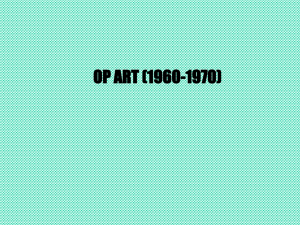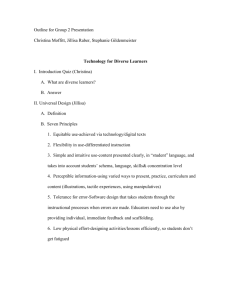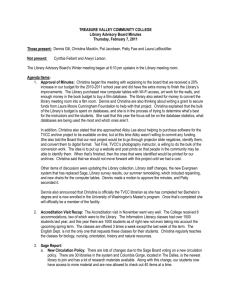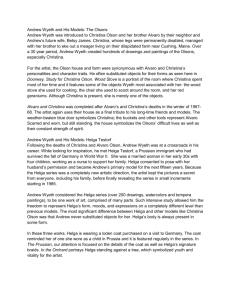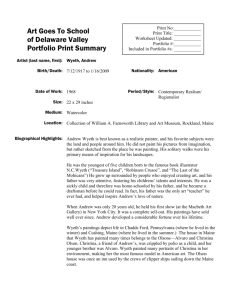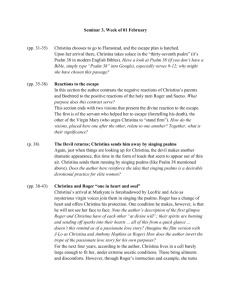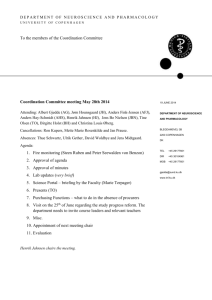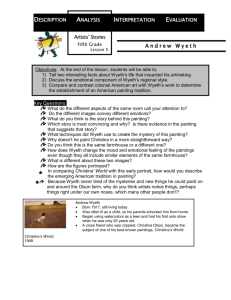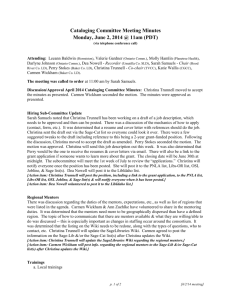Slide Show Two
advertisement
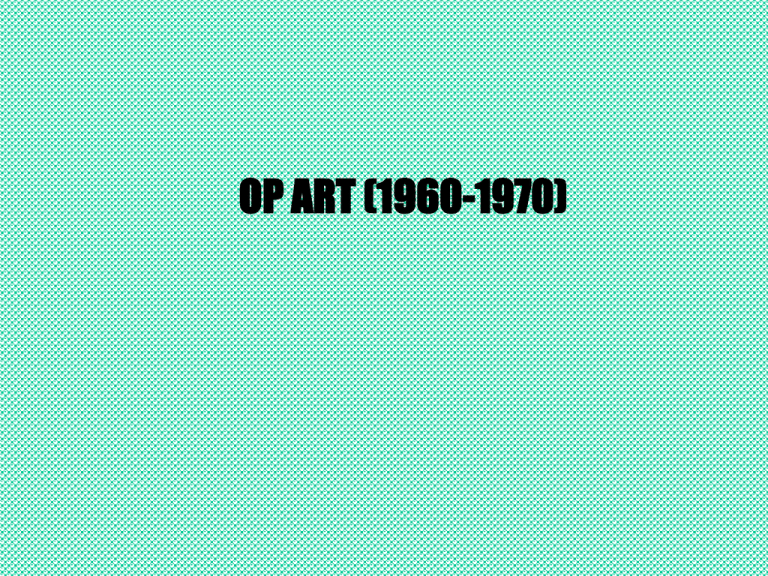
OP ART (1960-1970) Bridget Riley, born 1931 Shadowplay, 1990 The British painter Bridget Riley rose to prominence in the 1960s as one of the leading practitioners of what became known as Op Art, an international abstract movement concerned with visual effects and illusions. Complimentary colors and pattern/repetition are key elements of her work. Of her work, Riley said, "In my earlier paintings, I wanted the space between the picture plane and the spectator to be active. It was in that space, paradoxically, the painting took place.“ “Then, little by little, and, to some extent deliberately, I made it go the other way, opening up an interior space, as it were, so that there was a layered, shallow depth. It is important that the painting can be inhabited, so that the mind's eye, or the eye's mind, can move about it credibly.” Of her paintings, she has also commented, “the eye can travel over the surface in a way parallel to the way it moves over nature. It should feel caressed and soothed, experience frictions and ruptures, glide and drift…One moment there will be nothing to look at and the next second the canvas seems to refill, to be crowded with visual events.” BRIDGET RILEY (born 1931) Conversation (1992) Bridget Riley Cataract 3, 1967 PVA on Canvas, 87x873/4 in. Vasarely, Victor Untitled Victor Vasarely, artist French, 1908 - 1997 Capella III, 1967 Color screenprint in black and gold Gift of the Pantechnicon Victor Vasarely 1908–1997 Known as the “father of Op Art. He began painting the geometrical abstractions that led to birth of Op Art. Initially, he drew inspiration from the crackled tiles he looked at every day while waiting for the underground train in Paris. When he began using brighter, more vibrant colors, his works further enhanced the suggestion of movement through optical illusion. Victor Vasarely, French DEUTON MC, from the series of eight prints Homage to the Hexagon, 1969 Screenprint Image: 60.5 x 60.5 cm (23 13/16 x 23 13/16 in.) Sheet: 68 x 68 cm (26 3/4 x 26 3/4 in.) American Realism (Representationalism) 1940s - Present Triple Selfportriat 1960: Saturday Evening Post Cover - 13 February 1960 Symbolism in Triple Self-portrait Portraits of other master painters (Durer, Rembrandt, Van Gogh, and Picasso) surround him--suggesting he places himself in an equal relation to them; his own sketches for the work in progress are at the left Mirror—symbol of an image of himself; it is devoid of personality (can’t even see his eyes); it is a mask he wears that differs from who he is inside; the three different views beg the question of who he really is Discarded paper—likenesses he rejected (defining himself?) American symbol—he paints the story of America 1926: Saturday Evening Post Cover 24 April 1926 WYETH, Andrew Christina's World 1948 Tempera The Museum of Modern Art, New York An eighteenth century sea captain's house in Cushing, Maine haunted Andrew Wyeth CHRISTINA OLSON In 1890 Katie Hathorn was the last surviving child of a long line of Hathorns who made their home in the large white house located near the end of Hathorn Point. Katie met Johan Olauson, a young sailor from Sweden who had to spend the winter in Cushing since the schooner he was working on was icebound. They married two years later and Johan changed his name to John Olson. The couple took over the running of the Olson farm. In 1893 their first child was born, named Anna Christina. The family grew and three younger brothers joined Christina. Christina and her brothers attended the local schools but her mother soon noticed that Christina had a weakness in her legs and fell more often than the other children. Katie sewed kneepads to protect her daughter from her many falls. As Christina grew to be a young woman she attended social functions that were common for small towns of that time. This included dances at the Grange, church socials and a variety of social club events. But by the age of twenty-six Christina found it increasingly difficult to stand without outside support. Her parents sent her to Boston City Hospital. She hated her stay in the hospital where the doctors told her that her condition would not improve. Christina's mother died in 1927 and her father followed in 1935. By 1935 Christina lived alone in the Olson House with her brother Alvaro. She continued to be involved with local social functions where her baked goods were highly prized. One of Christina’s friends, Betsy James, brought a young artist by the name of Andrew Wyeth to meet the Olsons. Wyeth was immediately taken with the old farm and with the brother and sister who lived there. Andrew married Betsy in 1940 and often visited the Olson farm. Wyeth did many drawings, watercolors and tempera paintings of the farm and Christina over the nearly three decades that he knew the Olsons. He claimed, “In the portraits of that house, the windows are eyes or pieces of the soul almost. To me, each window is a different part of Christina’s life.” Christina's disability increased with age. When she was fifty-three, she was unable to stand and stopped walking, resorting to only crawling to get where she wanted to go. Christina's World, painted in 1948 by Andrew Wyeth immortalized Christina forever in the minds of millions of people. Christina Olson died in January of 1968 one month after her brother Alvaro’s death in December of 1967. Andrew Wyeth American, born 1917 Brandywine Valley, 1940 watercolor on wove paper, 55.6 x 76.3 cm (21 7/8 x 30 1/16 in.) The Armand Hammer Collection 1991.217.72 The Art Institute of Chicago and VAGA, New York, NY Grant Wood American, 1891-1942 American Gothic, 1930 Oil on beaverboard 74.3 x 62.4 cm John Currin Stamford After Brunch, 2000 Super realism or photo-realism Richard Estes Born 1932 in Kewanee, IL Lives and works in New York, NY Water Taxi, Mount Desert, 1999 oil paint on canvas Richard Estes oil paint on canvas Richard Estes TITLE: Market Basket Harley ARTIST: Tom Blackwell WORK DATE: 2007 MATERIALS: Acrylic on paper SIZE: h: 16.5 x w: 22 in / h: 41.9 x w: 55.9 cm TITLE: Sagaponack Sunday ARTIST: Tom Blackwell WORK DATE: 2003 MATERIALS: Oil on linen SIZE: h: 48 x w: 72 in / h: 121.9 x w: 182.9 cm TITLE: Ferrariworld, Fall ARTIST: Tom Blackwell WORK DATE: 2006 MATERIALS: huile sur toile SIZE: h: 101.6 x w: 152.4 cm / h: 40 x w: 60 in Tom Blackwell Chuck Close Nancy, 1968. Acrylic on canvas. Milwaukee Art Museum Gift of Herbert H. Kohl Charities, Inc. Chuck Close Bob Chuck Close Chuck Close "The Event" On December 7, 1988, Close felt a strange pain in his chest. That day he was at a ceremony honoring local artists in New York City and was waiting to be called to the podium to present an award. Close delivered his speech and then made his way across the street to Beth Israel Medical Center where he suffered a seizure which left him paralyzed from the neck down. The cause was diagnosed as a spinal artery collapse. Close called that day "The Event." For months Close was in rehab strengthening his muscles; he soon had slight movement in his arms and could walk, yet only for a few steps. He has relied on a wheelchair since. However, Close continued to paint on with a brush strapped onto his wrist with tape, creating large portraits in low-resolution grid squares created by an assistant. Viewed from afar, these squares appear as a single, unified image which attempt photo-reality, albeit in pixilated form. Although the paralysis restricted his ability to paint as meticulously as before, Close had, in a sense, placed artificial restrictions upon his hyper-realist approach well before the injury. He had adopted materials and techniques that did not lend themselves well to achieving a photorealistic effect. Close proved able to create his desired effects even with the most difficult of materials to control. Chuck Close Self Portrait, 1997. Pixel style portrait. Crayola, 1972-3 28 x 40 Audrey Flack Wildlife Art 1970-Present Terry Redlin Wild Wings He is one of the country's most widely collected painters of wildlife and Americana. Terry Redlin Autumn Glow Having retired in 2007 Redlin reflected on his career, saying, “I wanted to tell stories with my paintings, to remember the experiences of my youth, and to imagine and capture forever events that have been related to me by older folks I have had the pleasure of knowing.” “America’s rural past, in my eyes, was a wonderful place full of both beauty and opportunity. How fortunate I’ve been to spend my life creating memories of those distant times for others to enjoy.” Eileen Doughty's specialty is creating landscape art quilts; she has said that she loves “the concept of ‘place’” so her “preferred subject matter” is the landscape. detail from “Prairie Roots Run Deep” William Millonig "Windfall Crossing" Whitetail 24" x 33" - Oil Bill and his family live in the heart of Wisconsin's Kettle Moraine. He has been painting since he was a young boy getting early training from his mother, who was an artist, and later from several schools and artists in Wisconsin and Minnesota. William Millonig "Cattails and Rooster Tails" LeRoy Niemann “Family Portrait” LeRoy Niemann “Portrait of the Lion” Sports Art 1970 - Present LeRoy Neimann “Magic” 1988 LeRoy Niemann “Chipping On” 1972 Robert Riger “Victory in the Mud” 1994 Riger created his first sport art from an Army-Navy football game that required five lithograph pencils and 140 hours. Robert Riger “Rocky Marciano” Robert Riger “Dolph Schayes”
